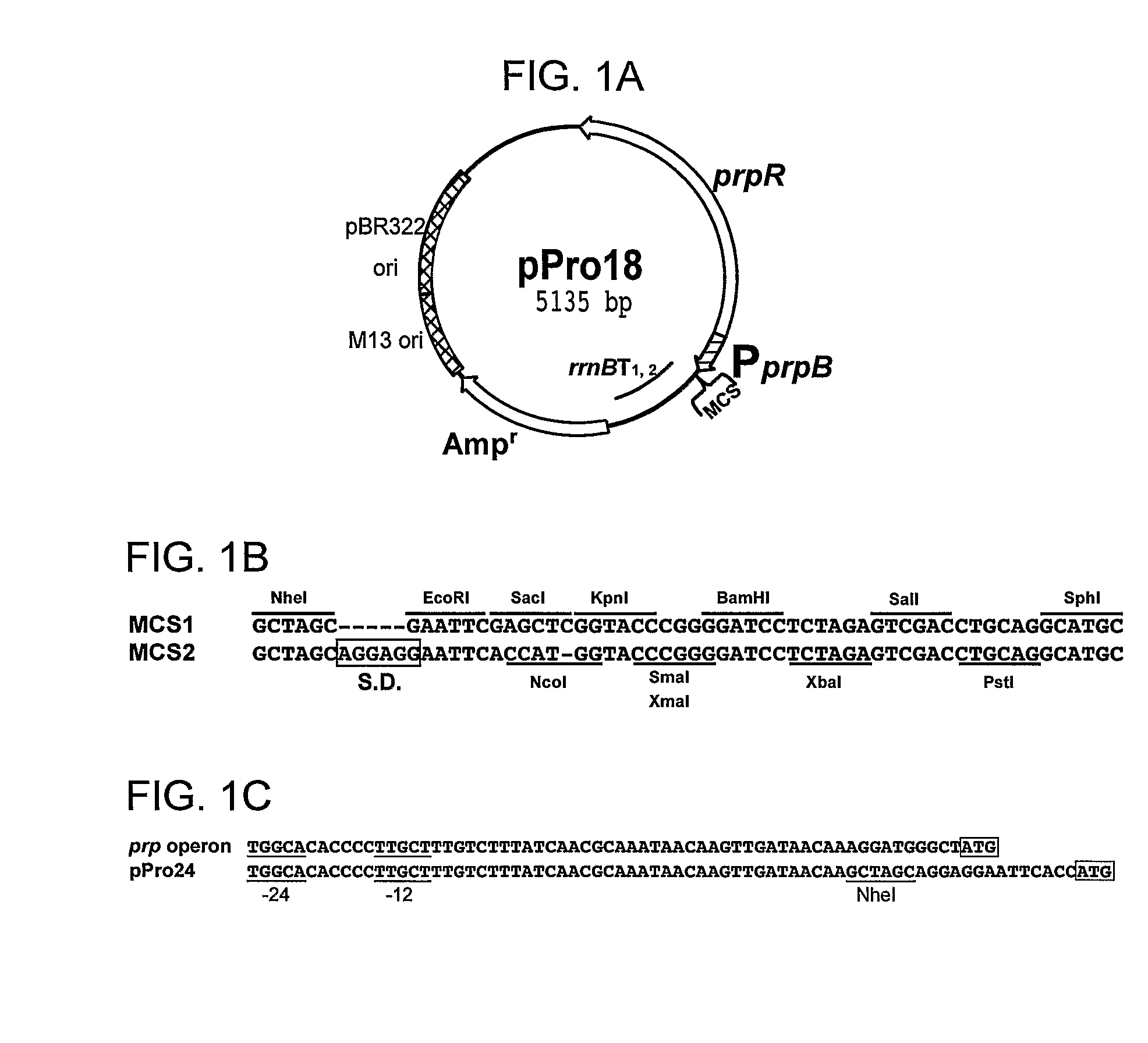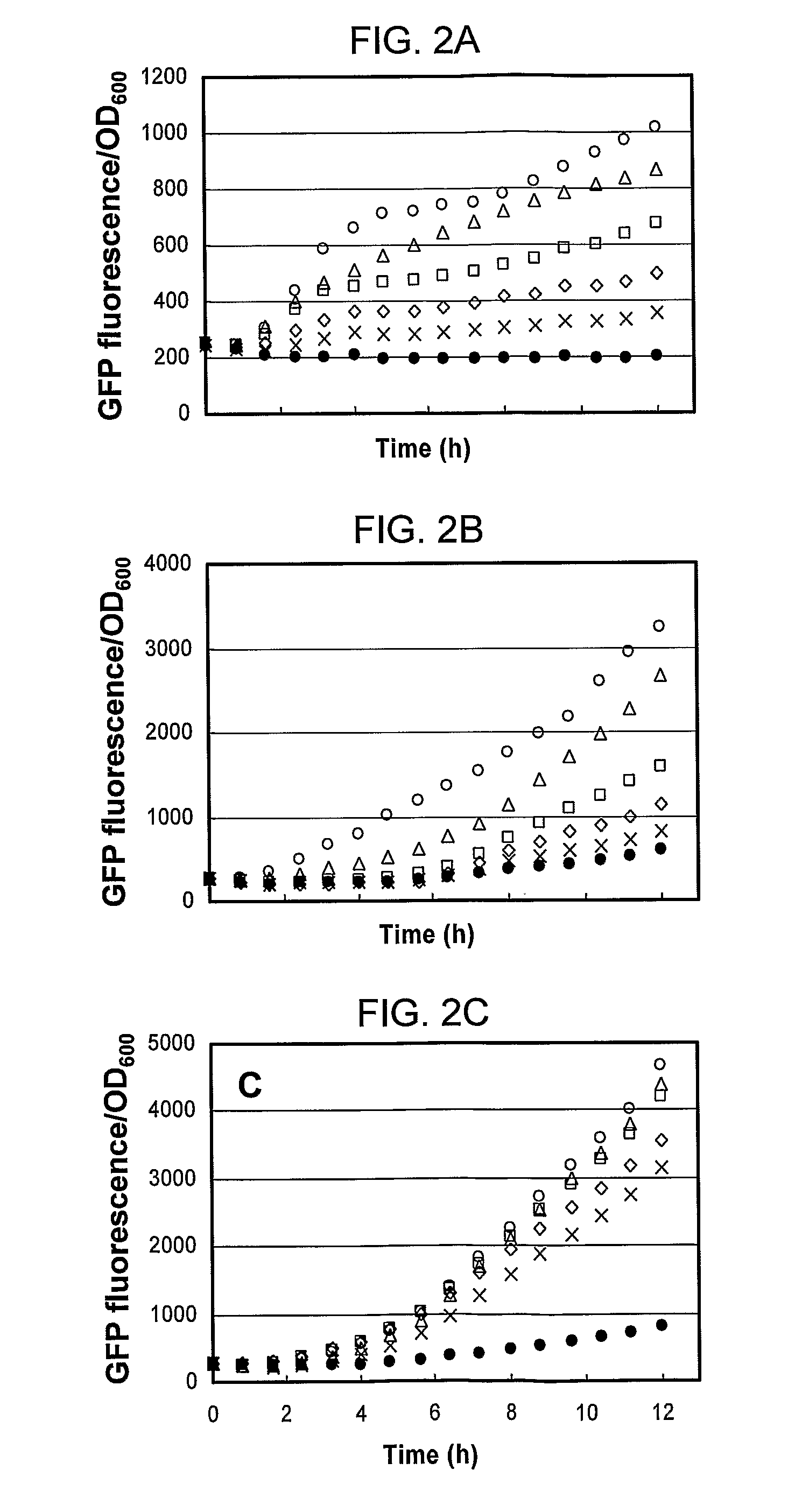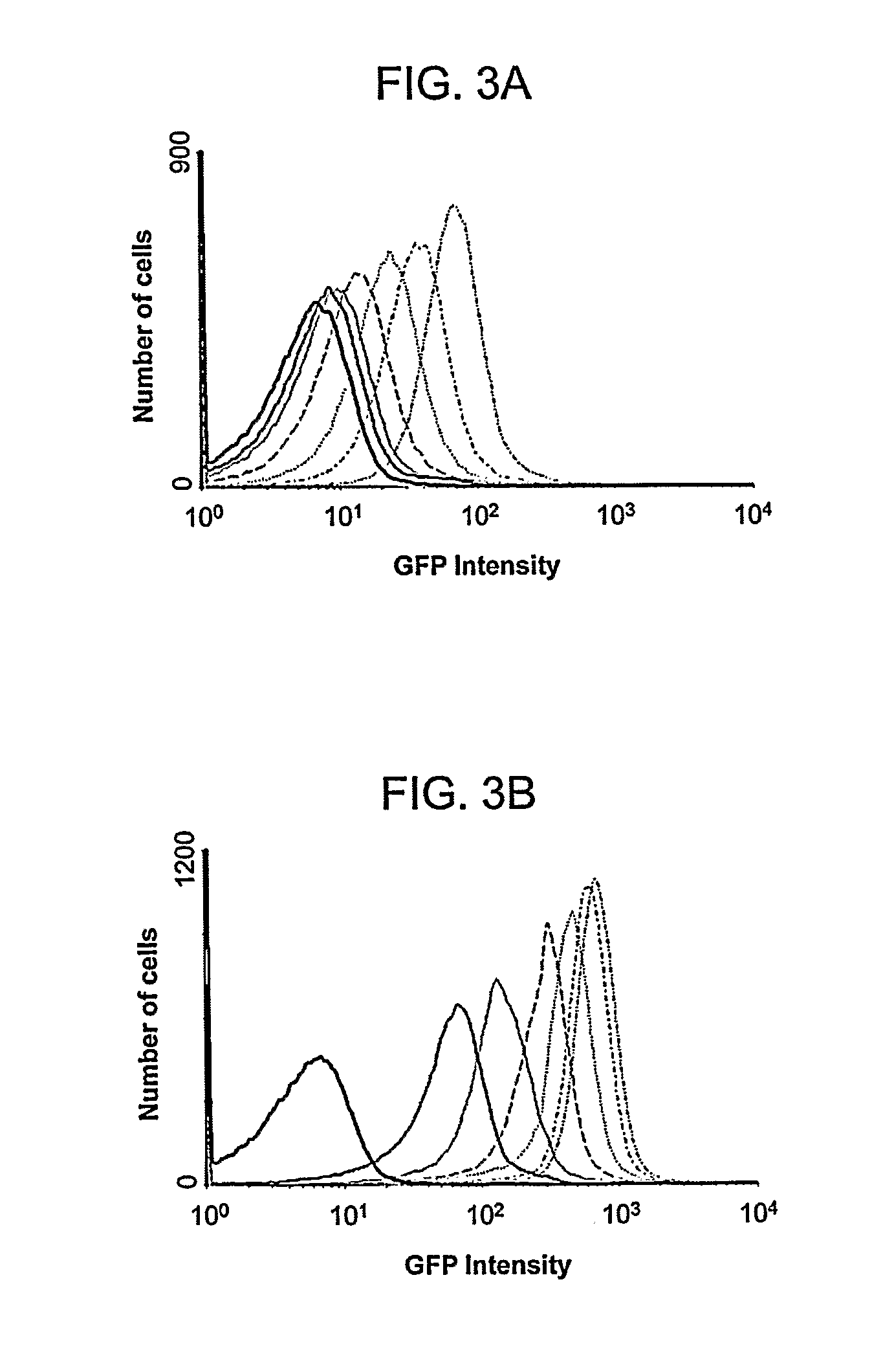Inducible expression vectors and methods of use thereof
a technology of expression vectors and expression methods, applied in the field of inducible expression vectors, can solve the problems of weaker methods, easy contamination of protein products by iptg, and unattractive options for methods
- Summary
- Abstract
- Description
- Claims
- Application Information
AI Technical Summary
Problems solved by technology
Method used
Image
Examples
example 1
Propionate-Inducible Expression Vectors
Materials and Methods
[0069]Bacterial strains and media. The bacterial strains used in this study are listed in Table 1.
[0070]
TABLE 1E. coli strains and plasmids used in this study.ReferenceStrains or plasmidsDescriptionor sourceStrainsDH10BF−mcrA Δ(mrr-hsdRMS mcrBC) φ80dlacZΔM15 ΔLifelacX74 deoR recA1 araΔ139 Δ(ara leu)7697 galUTechnologiesgalKλ−rpsL endA1 nupG StrrBL21F ompT[lon] hsdSB(rB mB) gal dcmNovagenBL21(DE3)F ompT[lon] hsdSB(rB mB) gal dcm λDE3NovagenJSBBL21(DE3) / Δ(sbm-ygfDGHI)This workS. entericametE205 ara-9ReferenceTR6583PlasmidsP70GLpBAD24 carrying gfpuv and lacZ, Apr37pTrc99A-gfppTrc99A carrying gfpuv, AprThis workpTrc99Atrc promoter, lac1q, pBR322 ori, AprAmershamPharmacia BiotechpPro182-MC inducible, pBR322 ori, AprThis workpPro18-Cm2-MC inducible, pBR322 ori, CmrThis workpPro18-Kan2-MC inducible, pBR322 ori, KmrThis workpPro242-MC inducible, pBR322 ori, AprThis workpPro302-MC inducible, p15A ori, AprThis workpPro332-MC inducibl...
example 2
[0092]The DNA regions that contain the PprpB promoter and the prpR gene were amplified from E. coli BL21 (DE3) and S. enterica genomic DNA. The araC gene and PBAD promoter of the pBAD24 and pBAD18 vectors were replaced with the PCR-amplified prpR gene and the PprpB promoter of E. coli (E) or S. enterica (S) strains, creating pPro24(E) / pPro24(S) and pPro18(E) / pPro18(S), respectively. The pPro18 vector is represented in FIG. 1A-C.
Reporter Plasmid Construction
[0093]The promoter-reporter gene plasmids were made to test the utility of the pPro vectors for the regulated expression of genes. The constructs, pBAD24-gfp, pET31b-gfp, pPro24(E)-gfp, pPro24(S)-g, and pTrc99A-gfp were constructed by subcloning the PCR-amplified gfpuv gene encoding the UV-excitable green fluorescent protein (GFP) from the p70GL plasmid into the MCS of the vector pBAD24, pET31b, pPro24(E), pPro24(S), and pTrc99A, respectively. Plasmid pPro7(S)-gfp was constructed by subcloning the PCR-amplified gfpuv plus the AAGA...
example 3
Propionate-Regulated High-Yield Protein Production in Escherichia coli
Materials and Methods
[0115]Bacterial strains and media. The bacterial strains used in this study are listed in Table II. Cultures were grown in Luria-Bertani (LB) medium at 37° C. Cell growth was monitored as the optical density at a wavelength of 600 nm (OD600). Media were supplemented with ampicillin (100 μg / ml). Arabinose, IPTG, or sodium propionate (pH 8.0) was used as an inducer.
[0116]
TABLE IIStrains or plasmidsDescriptionStrainsDH10BF−mcrA Δ(mrr-hsdRMS mcrBC) φ80dlacZΔM15 ΔlacX74 deoR recA1 araΔ139 Δ(ara leu)7697 galUgalK λ rpsL endA1 nupG StrrBL21F ompT hsdS (rB mB)gal dcmBL21(DE3)F ompT hsdS(rB mB) gal dcm λDE3MG1655F λ rph-1W3110F λ IN(rrnD-rrnE)1 rph-1TR6583metE205 ara-9Plasmidsp70GLpBAD24 carrying gfpuv and lacZ, pBR322 ori, AprpBAD24-gfppBAD24 carrying gfpuv, pBR322 ori, AprpET16b-gfppET16b carrying gfpuv, pBR322 ori, AprpET31b-gfppET31b carrying gfpuv, pBR322 ori, AprpTrc99A-gfppTrc99A carrying gfpuv...
PUM
| Property | Measurement | Unit |
|---|---|---|
| concentrations | aaaaa | aaaaa |
| temperature | aaaaa | aaaaa |
| temperature | aaaaa | aaaaa |
Abstract
Description
Claims
Application Information
 Login to View More
Login to View More - R&D
- Intellectual Property
- Life Sciences
- Materials
- Tech Scout
- Unparalleled Data Quality
- Higher Quality Content
- 60% Fewer Hallucinations
Browse by: Latest US Patents, China's latest patents, Technical Efficacy Thesaurus, Application Domain, Technology Topic, Popular Technical Reports.
© 2025 PatSnap. All rights reserved.Legal|Privacy policy|Modern Slavery Act Transparency Statement|Sitemap|About US| Contact US: help@patsnap.com



